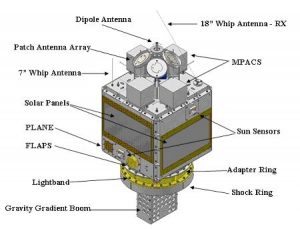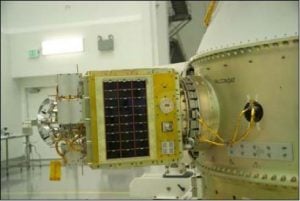 FalconSAT-3 was built in 2005 and 2006 by cadets and faculty in the Space Systems Research Center at the US Air Force Academy in Colorado Springs, CO. It is the fourth in a series of small satellites designed, built and operated there as part of a capstone course and which brings together about 30 cadets each year from several different academic departments.
FalconSAT-3 was built in 2005 and 2006 by cadets and faculty in the Space Systems Research Center at the US Air Force Academy in Colorado Springs, CO. It is the fourth in a series of small satellites designed, built and operated there as part of a capstone course and which brings together about 30 cadets each year from several different academic departments.
Since its launch on an Atlas V from Cape Canaveral in March, 2007, it has been through two mission phases and is now entering its third. The first mission phase was operation of the science payloads. In the second it was used as a tool for training cadets in the space operations squadron and students in both undergraduate space training in California and graduate students at the Air Force Institute of Technology. Finally, it’s third planned mission phase is an on-orbit resource in the Amateur Radio Service (ARS). The first two phases are complete and the ARS payload has now been activated. Operation as an ARS satellite is being managed by AMSAT-NA.
 In amateur service the downlink is at 435.103 MHz transmitting 1W into a ¼ whip that extends from a corner of the satellite near the Lightband separation ring. The uplink is at 145.840 MHz and the receive antenna is a ¼ whip on the opposite side of the satellite near the S-band antennas. All UHF and S-band equipment on NTIA licensed frequencies has been disabled. The ARS VHF receiver is very sensitive. Modulation is 9600 bps GMSK for the uplink and downlink. The broadcast callsign is PFS3-11, and the BBS callsign is PFS3-12, Unproto APRS via PFS3-1.
In amateur service the downlink is at 435.103 MHz transmitting 1W into a ¼ whip that extends from a corner of the satellite near the Lightband separation ring. The uplink is at 145.840 MHz and the receive antenna is a ¼ whip on the opposite side of the satellite near the S-band antennas. All UHF and S-band equipment on NTIA licensed frequencies has been disabled. The ARS VHF receiver is very sensitive. Modulation is 9600 bps GMSK for the uplink and downlink. The broadcast callsign is PFS3-11, and the BBS callsign is PFS3-12, Unproto APRS via PFS3-1.
The core avionics were designed and built by Mark, N4TPY, and Dino, KC4YMG at SpaceQuest Ltd and have performed remarkably well for 10 years on orbit. Jim, WD0E, was the lead engineer for FalconSAT-3 at the AFA and managed the design, construction, testing and early operations of the satellite. Inquiries about current operations should be directed to AMSAT VP Operations Drew Glasbrenner, KO4MA ([email protected]).
Nearly 700 cadets at USAFA obtained their amateur radio licenses as part of training to operate FalconSAT-3 and other USAFA satellites. They have taken that knowledge and understanding of the value of the ARS into their Air Force service and many on into industry. Since FalconSAT-3 the USAFA Astronautics Department has built and operated one additional satellite and has two more queued for launch. The space operations curriculum and the ground station are being rebuilt and configured for these new space assets.
The success of FalconSAT-3 is an excellent example of how amateur radio can be integrated into the curriculum of an education institution for the benefit of the students and the amateur radio service.
Supplemental chapter to Getting Started with Amateur Satellites:
Explanation of FalconSAT-3 Status / Information Packets:
WISP Chapter from 2005 AMSAT Digital Satellite & Telemetry Guide
Software for operating via the Packet BBS:
